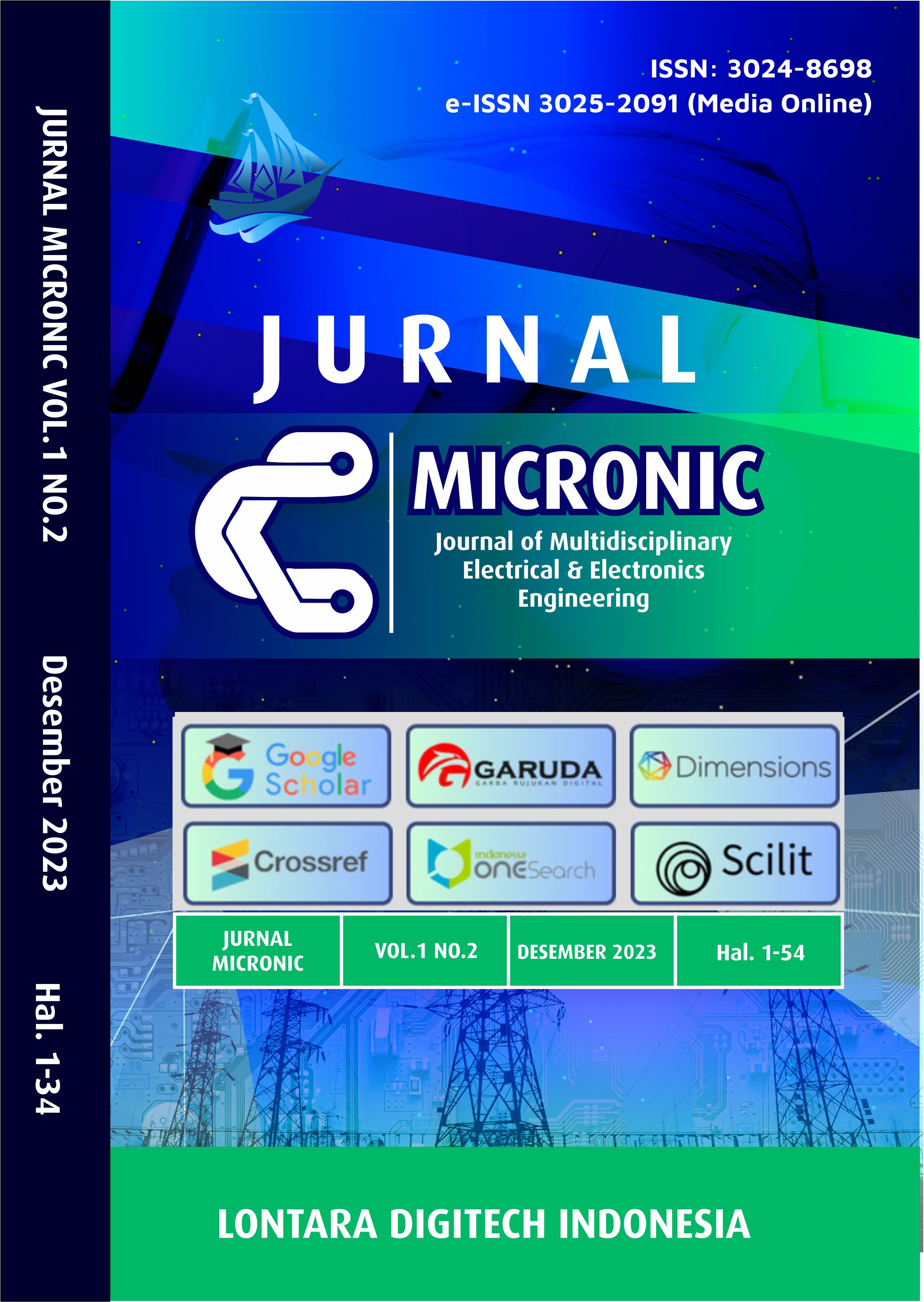Pemrograman robot berbasis Flowchart dengan media Fischertechnik Robopro
DOI:
https://doi.org/10.61220/micronic.v1i2.2023Keywords:
flowchart, pemrograman robot, fischertechnikAbstract
Dalam suatu proyek rancang bangun robot, dibutuhkan beberapa keahlian yang pada umumnya terdiri dari bidang ilmu desain, mekanik, elektronik dan pemrograman. Kolaborasi antar bidang ilmu ini dituntut seefisien mungkin meminimalisir miskomunikasi dan memaksimalkan waktu rancang bangun. Untuk meminimalisir miskomunikasi maka kita menggunakan flowchart kerja sebagai acuan, mengingat flowchart adalah alat komunikasi yang baik selain bahasa. Saat ini flowchart tidak hanya menjelaskan hal hal yang bersifat umum, tapi juga dapat membantu dalam pemrograman. Pemrograman robot biasanya menggunakan bahasa program C, Ruby atau sejenisnya, namun kekurangannya pemrograman seperti ini sangat membutuhkan waktu untuk dipelajari penggunaanya. Sehingga waktu pembuatan robot pun menjadi lebih lama. Sehingga munculnya pemikiran untuk mencari alternatif dari permasalahan ini salah satunya dengan mengembangkan flowchart dalam pemrograman. Penelitian ini bertujuan mengetahui bagaimana penggunaan flowchart sebagai alat pemrograman Robot mulai dari beberapa simbol dasar, pemanggilan sub program, percabangan tanpa syarat maupun bersyarat, variable inputan dengan nilai, hingga beberapa simbol yang dibuat khusus untuk fungsi tertentu. Penelitian ini menggunakan perangkat lunak Fischertechnik Robopro dan perangkat keras dengan permainan edukatif bongkar pasang merek Fischertechnik yang dirangkai menjadi beberapa rangkaian input, output, dan kendalian. Hasil dari penelitian ini kita peroleh penggunaan flowchart yang sesuai dengan simbolnya dalam mengeksekusi pemrograman seperti halnya menggunakan pemrograman dengan bahasa program. Untuk penelitian selanjutnya perlu diperbandingan antara flowchart yang dibuat berdasarkan program dari simulator dengan flowchart program robot untuk tugas yang sama.
References
Khan Maqbool, Wu Xiaotong, Xu Xiaolong, Dou Wanchun, Big data challenges and opportunities in the hype of Industry 4.0, in: IEEE International Conference on Communications Institute of Electrical and Electronics Engineers Inc, 2017.
Belhadi Amine, Zkik Karim, Cherrafi Anass, Yusof Sha'ri M., fezazi Said El, Understanding Big Data Analytics for Manufacturing Processes: Insights from Literature Review and Multiple Case Studies, Computers & Industrial Engineering 137 (2019).
Errandonea Itxaro, Beltrán Sergio, Arrizabalaga Saioa, Digital Twin for maintenance: A literature review, Computers in Industry 123 (2020).
Kritzinger Werner, Karner Matthias, Traar Georg, Henjes Jan, Sihn Wilfried, Digital Twin in manufacturing: A categorical literature review and classification, IFAC-PapersOnLine 51 (11) (2018) 1016–1022.
Cortés Daniel, Ramírez José, Villagómez Luis, Batres Rafael, Vasquez-Lopez Virgilio, Molina Arturo, Digital Pyramid: an approach to relate industrial automation and digital twin concepts, in: 2020 IEEE International Conference on Engineering, Technology and Innovation (ICE/ITMC), IEEE, 2020, pp. 1–7.
Rosin F., Forget P., Lamouri S., Pellerin R., Impact of Industry 4.0 on decision-making in an operational context, Advances in Production Engineering & Management 16 (4) (2021) 500–514.
Sudhoff Martin, Prinz Christopher, Kuhlenkötter Bernd, A Systematic Analysis of Learning Factories in Germany - Concepts, Production Processes, Didactics, Procedia Manufacturing 45 (2020) 114–120.
Heschl, Lukas, Thomas Dilger, Reinhard Bernsteiner, and Christian Ploder. ‘Digital Twin: decreasing the cognitive load by using Industry 4.0 simulation’.
Krathwohl David R., A revision of Bloom's taxonomy: An overview, Theory into practice 41 (4) (2002) 212–218.
Hercko Jozef, Her Jozef, Slamková Eva, Hnát Jozef, Industry 4.0 as a factor of productivity increase, in: Proceedings of TRANSCOM PROCEEDINGS 2015-11th European Conference of young researchers and scientists p, 2015, p. 188. 122.
Jaskó Szilárd, Skrop Adrienn, Holczinger Tibor, Chován Tibor, Abonyi János, Development of manufacturing execution systems in accordance with Industry 4.0 requirements: A review of standard- and ontology-based methodologies and tools, Computers in Industry 123 (2020).
Sahal Radhya, Breslin John G., Ali Muhammad Intizar, Big data and stream processing platforms for Industry 4.0 requirements mapping for a predictive maintenance use case, Journal of Manufacturing Systems 54 (2020) 138–151.
Pereira A.C., Romero F., A review of the meanings and the implications of the Industry 4.0 concept, Procedia Manufacturing 13 (2017) 1206–1214.
Sima Violeta, Gheorghe Ileana Georgiana, Subić Jonel, Nancu Dumitru, Influences of the Industry 4.0 Revolution on the Human Capital Development and Consumer Behavior: A Systematic Review, Sustainability 12 (10) (2020) 4035.
Ladj Asma, Wang Zhiqiang, Meski Oussama, Belkadi Farouk, Ritou Mathieu, Cunha Catherine Da, A knowledge-based Digital Shadow for machining industry in a Digital Twin perspective, Journal of Manufacturing Systems 58 (2021) 168–179.
Bergs Thomas, Gierlings Sascha, Auerbach Thomas, Klink Andreas, Schraknepper Daniel, Augspurger Thorsten, The Concept of Digital Twin and Digital Shadow in Manufacturing, Procedia CIRP 101 (2021) 81–84.
Franzen Julian, Stecken Jannis, Pfaff Raphael, Kuhlenkötter Bernd, Using the Digital Shadow for a Prescriptive Optimization of Maintenance and Operation, in: Clausen Uwe, Langkau Sven, Kreuz Felix (Eds.), Advances in Production, Logistics and Traffic Cham, Springer International Publishing, 2019, pp. 265–276. Lecture Notes in Logistics.
Lu Yuqian, Liu Chao, Wang Kevin I.-Kai, Huang Huiyue, Xu Xun, Digital Twin-driven smart manufacturing: Connotation, reference model, applications and research issues, Robotics and Computer-Integrated Manufacturing 61 (2020).
Hernandez-de-Menendez Marcela, Morales-Menendez Ruben, Escobar Carlos A., McGovern Megan, Competencies for Industry 4.0, International Journal on Interactive Design and Manufacturing (IJIDeM) 14 (4) (2020) 1511–1524.
Tyler-Wolfe, Adam. ‘Pypeline’.GitHub.
Richardson, L. (2007) ‘Beautiful soup documentation.’
Bowen, Dillon. (2020) ‘Selenium-Tools’.
Downloads
Published
Citation
Issue
Section
License
Copyright (c) 2023 Aulia Sabril (Author)

This work is licensed under a Creative Commons Attribution-ShareAlike 4.0 International License.










 Email : micronic.lontara@gmail.com
Email : micronic.lontara@gmail.com
